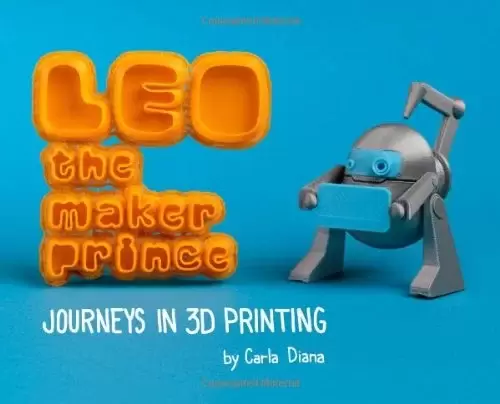
Book Description
LEO the Maker Prince teaches children (both young and old) about 3D printing by following Carla and LEO’s journey through Brooklyn. LEO is a walking, talking robot who has the magical ability to to print (in plastic) any object that Carla draws. The other robots have their own special capabilities: H1-H0 prints in metal, Sinclair-10 can find and print objects from a huge catalog of designs, and the others (including AL1C3-D, IRIS-7, and NiXie) have unique talents, too. Readers can come along for the journey, too: all of the objects in the book are printable one way or another.
3D Printing Insights from Author Carla Diana
- Interesting artifacts and textures sometimes emerge as a byproduct of the 3D printing process. The cover letters for LEO were the result of a “happy accident.” A print of some standard extruded lettering was stopped halfway through, and the letterforms that emerged were more unique than what we had originally designed. People often ask us what typeface it is and we love describing how it was formed from a print that’s halfway done.
- By printing a hollow piece and then pausing the printer halfway through, you can take advantage of “throw-ins” to give an object special properties. For example, magnets or metal parts can be thrown in to make your pieces stick together. In LEO, we used rice as a throw-in to make a shaker instrument.
- The 3D modeling software Rhino has a plugin for Python scripting that allows people to use code to generate forms based on algorithms. For example, the jewelry that the character Stephanie creates is based on mathematical spirals.
- It’s fun to experiment with different polishes to change the surface of 3D-printed parts. Acetone (the same thing that’s in nail polish remover) can be brushed on the surface of an ABS or PLA print to make it smooth and shiny.
- When 3D-printing food, it’s important to design for two-and-a-half dimensions: This means a 3D object where higher layers do not hang above lower layers in the 3D print. This helps you avoid sagging.
中文:
书名:制造者利奥王子:3D打印之旅
电影制作人利奥·普林斯跟随卡拉和利奥在布鲁克林的旅程,向孩子们(无论老少)传授3D打印知识。利奥是一个会走路、会说话的机器人,他拥有神奇的能力,可以(用塑料)打印卡拉画的任何东西。其他机器人有自己的特殊能力:H1-H0金属打印,辛克莱-10可以从大量设计中找到并打印物体,其他机器人(包括AL1C3-D,IRIS-7和Nixie)也有独特的天赋。读者也可以一起来:书中的所有对象都可以以某种方式打印出来。
3D打印作者卡拉·戴安娜的见解
- 有趣的人工制品和纹理有时会作为3D打印过程的副产品出现。莱昂纳多的求职信是一次“快乐的意外”的结果。一些标准挤压字母的印刷在中途停了下来,出现的字体比我们最初设计的更独特。人们经常问我们它是什么字体,我们喜欢描述它是如何从一个半成品的印刷品形成的。
- 通过打印一个中空的部分,然后在打印到一半时暂停打印机,您可以利用“附加”来赋予对象特殊的属性。例如,可以把磁铁或金属部件扔进去,让你的碎片粘在一起。在狮子座,我们用大米做了一个摇摆器。
- 3D建模软件Rhino有一个用于Python脚本编写的插件,允许人们使用代码根据算法生成表单。例如,角色斯蒂芬妮创造的珠宝是基于数学螺旋线的。
- 用不同的抛光剂来改变3D打印部件的表面是一件有趣的事情。丙酮(和指甲油去污剂中的丙酮一样)可以刷在ABS或PLA印花的表面,使其光滑、有光泽。
- 当3D打印食品时,重要的是要进行两个半维度的设计:这意味着3D打印中的较高层不会悬挂在较低层之上。这可以帮助你避免松弛。
评论前必须登录!
注册